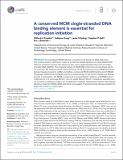A conserved MCM single-stranded DNA binding element is essential for replication initiation
Author(s)
Froelich, Clifford A.; Kang, Sukhyun; Epling, Leslie B.; Enemark, Eric J.; Bell, Stephen P
DownloadFroelich-2014-A conserved MCM sing.pdf (4.116Mb)
PUBLISHER_CC
Publisher with Creative Commons License
Creative Commons Attribution
Terms of use
Metadata
Show full item recordAbstract
The ring-shaped MCM helicase is essential to all phases of DNA replication. The complex loads at replication origins as an inactive double-hexamer encircling duplex DNA. Helicase activation converts this species to two active single hexamers that encircle single-stranded DNA (ssDNA). The molecular details of MCM DNA interactions during these events are unknown. We determined the crystal structure of the Pyrococcus furiosus MCM N-terminal domain hexamer bound to ssDNA and define a conserved MCM-ssDNA binding motif (MSSB). Intriguingly, ssDNA binds the MCM ring interior perpendicular to the central channel with defined polarity. In eukaryotes, the MSSB is conserved in several Mcm2-7 subunits, and MSSB mutant combinations in S. cerevisiae Mcm2-7 are not viable. Mutant Mcm2-7 complexes assemble and are recruited to replication origins, but are defective in helicase loading and activation. Our findings identify an important MCM-ssDNA interaction and suggest it functions during helicase activation to select the strand for translocation.
Date issued
2014-04Department
Massachusetts Institute of Technology. Department of BiologyJournal
eLife
Publisher
eLife Sciences Publications, Ltd.
Citation
Froelich, Clifford A, Sukhyun Kang, Leslie B Epling, Stephen P Bell, and Eric J Enemark. “A Conserved MCM Single-Stranded DNA Binding Element Is Essential for Replication Initiation.” eLife 3 (April 1, 2014). pp 1-21.
Version: Final published version
ISSN
2050-084X